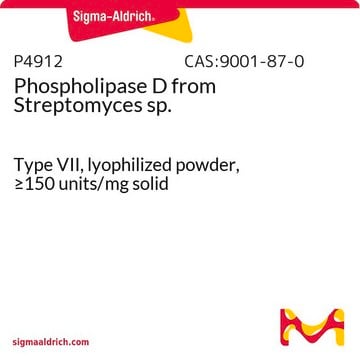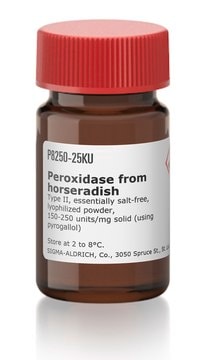C5896
Choline Oxidase from Alcaligenes sp.
lyophilized powder, ≥10 units/mg solid
Synonym(s):
Choline: oxygen 1-oxidoreductase
About This Item
Recommended Products
form
lyophilized powder
specific activity
≥10 units/mg solid
mol wt
~95 kDa
technique(s)
cell based assay: suitable
suitability
suitable for assay of choline
suitable for molecular biology
storage temp.
−20°C
Looking for similar products? Visit Product Comparison Guide
Application
- in a study to investigate a choline biosensor constructed with a chitinous membrane and its application in measuring cholinesterase inhibitory activities
- has also been used in spectroscopic studies on the photoreaction of choline oxidase with covalently bound flavin.
- as a component of phosphate buffer saline (PBS) buffer for measurement of choline acetyltransferase (ChAT) activity in brain tissue homogenates
- to measure the choline generated by autotaxin (ATX) by ATX activity assay and phospholipase-D (PLD) by PLD activity assay
Biochem/physiol Actions
Physical properties
Michaelis constants:2.84 x 10¯3M (Choline), 5.33 x 10¯3M (Betaine aldehyde)
Structure:One mol of FAD is covalently bound to mol of the enzyme
Inhibitors:p-Chloromercuribenzoate, Cu++, Co++, Hg++, Ag+
Optimum pH:8.0 – 8.5
Optimum temp:40 – 45°C
pH Stability:pH 7.0 – 9.0 (30°C, 2hr)
Thermal stability:Below 37°C (pH 7.5, 10min)
Unit Definition
related product
Signal Word
Danger
Hazard Statements
Precautionary Statements
Hazard Classifications
Resp. Sens. 1
Storage Class Code
11 - Combustible Solids
WGK
WGK 3
Flash Point(F)
Not applicable
Flash Point(C)
Not applicable
Personal Protective Equipment
Certificates of Analysis (COA)
Search for Certificates of Analysis (COA) by entering the products Lot/Batch Number. Lot and Batch Numbers can be found on a product’s label following the words ‘Lot’ or ‘Batch’.
Already Own This Product?
Find documentation for the products that you have recently purchased in the Document Library.
Customers Also Viewed
Our team of scientists has experience in all areas of research including Life Science, Material Science, Chemical Synthesis, Chromatography, Analytical and many others.
Contact Technical Service
















